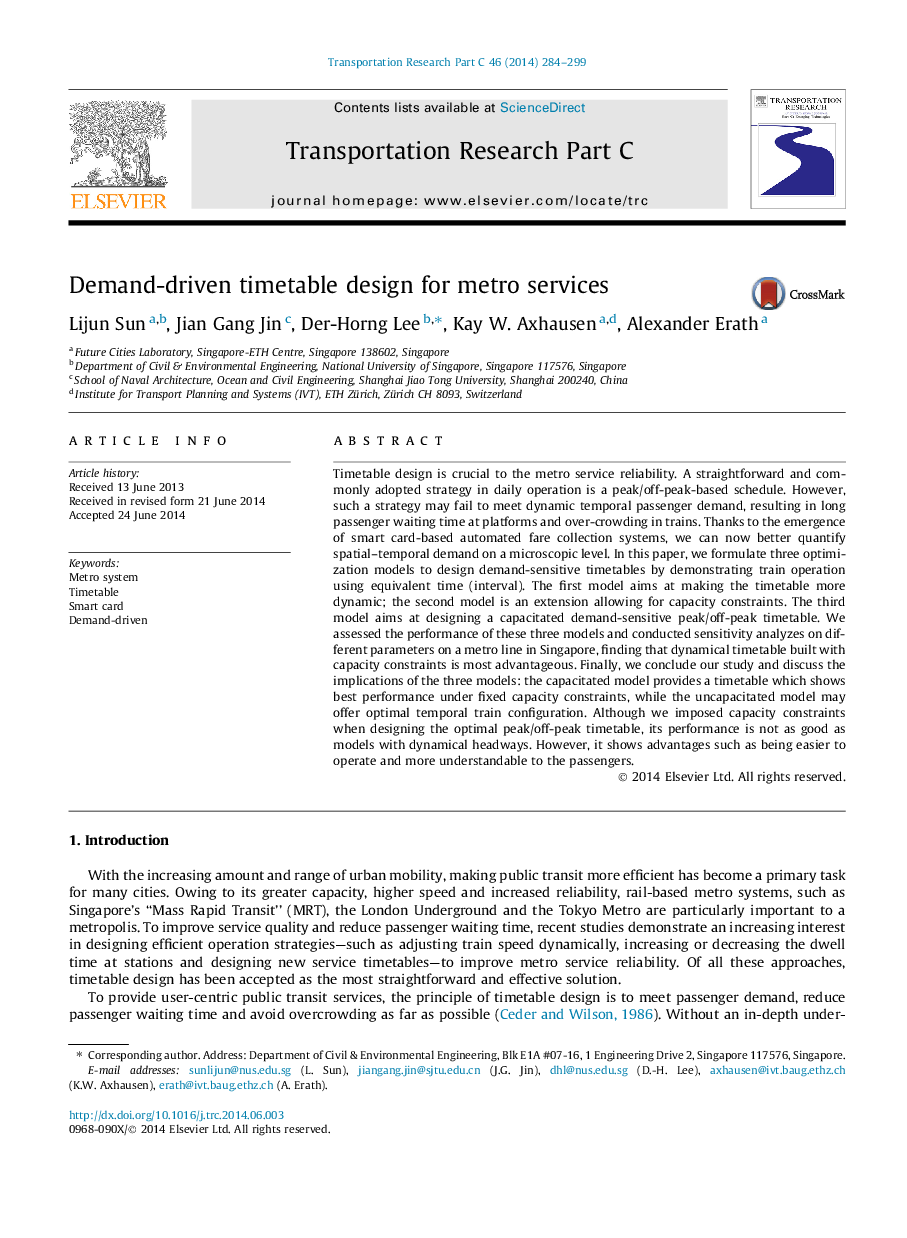| کد مقاله | کد نشریه | سال انتشار | مقاله انگلیسی | نسخه تمام متن |
|---|---|---|---|---|
| 6937143 | 868854 | 2014 | 16 صفحه PDF | دانلود رایگان |
عنوان انگلیسی مقاله ISI
Demand-driven timetable design for metro services
ترجمه فارسی عنوان
طراحی زمانبندی تقاضا برای خدمات مترو
دانلود مقاله + سفارش ترجمه
دانلود مقاله ISI انگلیسی
رایگان برای ایرانیان
کلمات کلیدی
سیستم مترو، جدول زمانی کارت هوشمند، تقاضای رانده شده،
ترجمه چکیده
طراحی جدول زمانی برای قابلیت اطمینان مترو بسیار ضروری است. استراتژی ساده و معمولی که در عملیات روزانه به کار گرفته می شود، برنامه ای است که بر اساس اوج / خاموش است. با این حال، چنین استراتژی ممکن است برای پاسخگویی به تقاضای مسافرتی پویا مواجه باشد، که منجر به انتظار طولانی مدت مسافر در سیستم عامل ها و بیش از حد جمعیت در قطار می شود. با توجه به ظهور سیستم های جمع آوری کرایه اتوماتیک مبتنی بر کارت های هوشمند، می توانیم تقاضای مکانی و زمانی را در سطح میکروسکوپی کم کنیم. در این مقاله، ما سه مدل بهینه سازی برای طراحی برنامه های زمان بندی حساس به تقاضا با نشان دادن عملیات قطار با استفاده از زمان معادل (فاصله) ارائه می دهیم. مدل اول هدف این است که زمانبندی بیشتر پویا باشد؛ مدل دوم توسعه دهنده است که به محدودیت های ظرفیت اجازه می دهد. مدل سوم با هدف طراحی یک برنامه زمانبندی حداکثر و غیرقابل پاسخگویی حساس به تقاضای خالی است. ما عملکرد این سه مدل را ارزیابی کردیم و تجزیه و تحلیل حساسیت را بر روی پارامترهای مختلف در یک خط مترو در سنگاپور انجام دادیم و نتیجه گرفتیم که جدول زمانبندی دینامیک ساخته شده با محدودیت های ظرفیتی بیشترین سود را دارد. در نهایت، ما نتیجه گیری مطالعه ما و بحث در مورد مفاهیم این سه مدل: مدل ظرفیت ارائه جدول زمانی که بهترین عملکرد را در محدودیت های ثابت ثابت نشان می دهد، در حالی که مدل بدون ظرفیت ممکن است پیکربندی قطار بهینه را ارائه دهد. اگرچه ما در هنگام طراحی برنامه زمانبندی بهینه / پیمایش مطلوب، محدودیتهای ظرفیتی را اعمال کردیم، عملکرد آن به عنوان مدلهایی با پیشرفتهای دینامیک خوب نیست. با این حال، این مزایا را نشان می دهد مانند کار آسان تر و قابل درک تر شدن به مسافران.
موضوعات مرتبط
مهندسی و علوم پایه
مهندسی کامپیوتر
نرم افزارهای علوم کامپیوتر
چکیده انگلیسی
Timetable design is crucial to the metro service reliability. A straightforward and commonly adopted strategy in daily operation is a peak/off-peak-based schedule. However, such a strategy may fail to meet dynamic temporal passenger demand, resulting in long passenger waiting time at platforms and over-crowding in trains. Thanks to the emergence of smart card-based automated fare collection systems, we can now better quantify spatial-temporal demand on a microscopic level. In this paper, we formulate three optimization models to design demand-sensitive timetables by demonstrating train operation using equivalent time (interval). The first model aims at making the timetable more dynamic; the second model is an extension allowing for capacity constraints. The third model aims at designing a capacitated demand-sensitive peak/off-peak timetable. We assessed the performance of these three models and conducted sensitivity analyzes on different parameters on a metro line in Singapore, finding that dynamical timetable built with capacity constraints is most advantageous. Finally, we conclude our study and discuss the implications of the three models: the capacitated model provides a timetable which shows best performance under fixed capacity constraints, while the uncapacitated model may offer optimal temporal train configuration. Although we imposed capacity constraints when designing the optimal peak/off-peak timetable, its performance is not as good as models with dynamical headways. However, it shows advantages such as being easier to operate and more understandable to the passengers.
ناشر
Database: Elsevier - ScienceDirect (ساینس دایرکت)
Journal: Transportation Research Part C: Emerging Technologies - Volume 46, September 2014, Pages 284-299
Journal: Transportation Research Part C: Emerging Technologies - Volume 46, September 2014, Pages 284-299
نویسندگان
Lijun Sun, Jian Gang Jin, Der-Horng Lee, Kay W. Axhausen, Alexander Erath,
